Tate & Lyle Bundle
Can Tate & Lyle Continue to Sweeten Its Success?
Tate & Lyle, a titan in the global food ingredients market, has undergone a remarkable transformation, evolving from its sugar-refining roots to become a leader in creating healthier and more sustainable food solutions. This strategic shift, highlighted by the pivotal CP Kelco acquisition in late 2024, has positioned the company at the forefront of consumer-driven innovation.
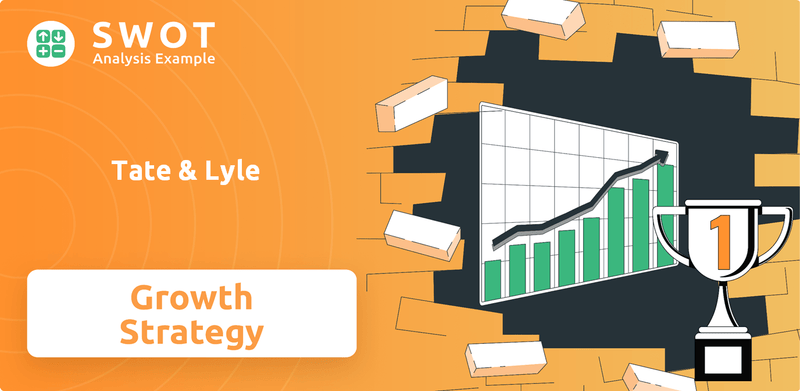
This exploration of Tate & Lyle's Tate & Lyle SWOT Analysis delves into its ambitious growth strategy and future prospects, examining how this global food industry player plans to navigate challenges and capitalize on opportunities within the dynamic landscape of the sustainable food solutions market. We'll analyze Tate & Lyle's expansion plans, investment in plant-based ingredients, and the competitive landscape to understand its long-term growth potential and impact on the food industry. Understanding Tate & Lyle's financial performance analysis will be key to assessing its future in the sugar substitute market and its role in reducing sugar consumption.
How Is Tate & Lyle Expanding Its Reach?
The expansion initiatives of the company are primarily driven by strategic acquisitions and a focus on growing market segments. A key strategy involves acquisitions to bolster its position in the food ingredients market. These moves are designed to strengthen its offerings and enhance its global footprint. The company's focus on sustainable food solutions is also a core part of its expansion strategy, aligning with growing consumer demand.
The company's strategic acquisitions and global footprint expansion are central to its Tate & Lyle Growth Strategy. These actions are aimed at increasing market share and driving revenue growth within the global food industry. The company's ability to innovate in sweeteners and invest in plant-based ingredients further supports its expansion plans. These initiatives are supported by strategic partnerships and a regional production model.
The company's approach includes a focus on enhancing its Sweetening and Fortification platforms. This is achieved through strategic acquisitions and a focus on key market segments. The company's commitment to sustainable food solutions and its global presence contribute to its long-term growth potential. These factors position the company to capitalize on opportunities within the food industry.
The acquisition of CP Kelco, completed in November 2024 for $1.8 billion, is a major step. This acquisition is aimed at becoming a leader in 'Mouthfeel' and enhancing Sweetening and Fortification platforms. The integration of CP Kelco is progressing well, with the combined business operating as one from April 1, 2025, which is expected to accelerate growth.
The company is focused on expanding its global presence. A targeted market penetration increase of 5% in key regions such as North America and Asia for 2024 is planned. Strategic partnerships with local distributors are crucial for enhancing supply chain capabilities in these new markets, supporting its global reach.
New product revenue saw a 10% like-for-like increase in the first half of fiscal year 2025. This growth was driven by strong demand for fibers. The company's focus on innovation helps to drive this positive financial performance, reflecting its investment in plant-based ingredients.
The company recently formed a new partnership with Manus for bio-converted stevia. This partnership supports the diversification of its product pipeline. This collaboration ensures the sourcing and production of stevia at scale in the Americas, contributing to its sustainability initiatives.
The company's expansion relies on strategic acquisitions, such as CP Kelco, and targeted market penetration in key regions. These actions support the company's long-term growth potential and its role in the global food industry. These initiatives are designed to enhance the company's position in the food ingredients market.
- Acquisition of CP Kelco to enhance Sweetening and Fortification platforms.
- Targeted market penetration increase of 5% in North America and Asia for 2024.
- New product revenue increased by 10% in the first half of fiscal year 2025.
- Partnership with Manus for bio-converted stevia production in the Americas.
Tate & Lyle SWOT Analysis
- Complete SWOT Breakdown
- Fully Customizable
- Editable in Excel & Word
- Professional Formatting
- Investor-Ready Format
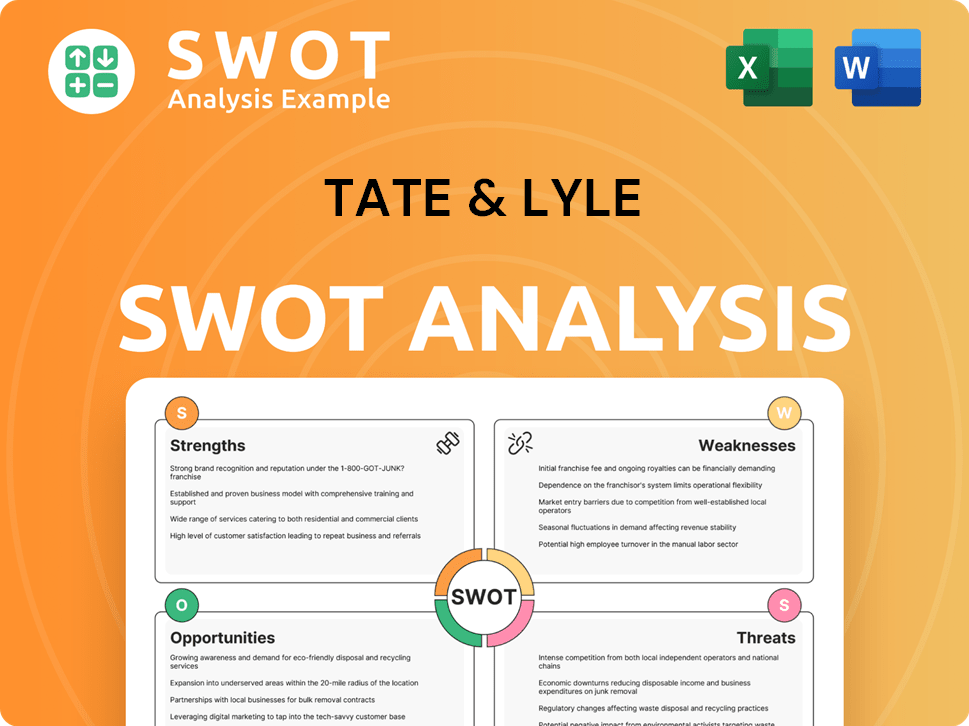
How Does Tate & Lyle Invest in Innovation?
The focus of the company's innovation strategy is to meet evolving consumer needs and preferences in the global food industry. Consumers are increasingly seeking healthier food options, driving demand for ingredients that reduce sugar, calories, and fat while enhancing nutritional value. This shift towards healthier eating habits is a key factor influencing the company's product development and market strategies.
The company's approach to innovation is centered on creating sustainable food solutions and providing ingredients that align with these health-conscious consumer demands. This includes developing new products and reformulating existing ones to improve nutritional profiles. The company's strategy is also influenced by global trends in food and beverage consumption, including the rise of plant-based diets and the growing importance of sustainable sourcing.
The company's commitment to innovation and technology is integral to its long-term growth potential, positioning it to capitalize on the evolving food ingredients market. The company's strategic initiatives are designed to address both current consumer preferences and future market trends, ensuring its continued success in a dynamic industry.
The company plans to invest £50 million in research and development (R&D) in 2024. This investment is directed towards creating new ingredients that meet consumer demands for healthier options, focusing on innovation in sweeteners and other food ingredients.
In 2023, the company launched over 20 new products. These products are designed to reduce sugar and increase fiber content in food and beverages, aligning with consumer preferences for healthier choices.
The company's expertise in reformulation is central to its strategy. This involves reducing sugar, calories, and fat while adding fiber and protein to improve the nutritional balance of food products. This approach helps customers meet evolving consumer demands.
Digital transformation and the use of cutting-edge technologies are integral to the company's strategy. This includes leveraging data analytics and digital tools to improve efficiency, enhance product development, and optimize supply chain management.
The company has ambitious science-based targets for greenhouse gas (GHG) emissions reduction, validated by the Science Based Targets initiative (SBTi). These initiatives are a key part of the company's long-term growth potential and commitment to sustainable food solutions.
The company is committed to achieving 100% renewable electricity usage in its manufacturing processes by 2025. As of 2023, the company had already reached 75% of this target. This commitment is a significant step towards reducing its environmental impact.
The company's technological and sustainability strategies are designed to drive both operational efficiency and environmental responsibility. These initiatives are critical to the company's long-term success, supporting its position in the global food industry.
- GHG Emissions Reduction: The company aims for a 38% absolute reduction in Scope 1 and 2 GHG emissions by 2028 from a 2019 base year, and a 38% absolute reduction in Scope 3 GHG emissions by 2028 from a 2019 base year.
- Renewable Electricity: The company is committed to using 100% renewable electricity in its manufacturing processes by 2025, with 75% achieved by 2023. Long-term Power Purchase Agreements (PPAs) in North America are expected to match all purchased electricity requirements, leading to over an 80% reduction in global Scope 2 GHG emissions.
- Deforestation Commitment: The company has committed to no deforestation across its primary deforestation-linked commodities by December 31, 2025. This commitment supports sustainable sourcing practices and reduces the environmental impact of its supply chain.
- Digital Tools: Utilizing digital tools for efficiency, product development, and supply chain optimization.
The company's focus on innovation, sustainability, and digital transformation positions it to capitalize on opportunities in the food ingredients market. For more insights into the company's financial performance and business model, you can explore the Revenue Streams & Business Model of Tate & Lyle.
Tate & Lyle PESTLE Analysis
- Covers All 6 PESTLE Categories
- No Research Needed – Save Hours of Work
- Built by Experts, Trusted by Consultants
- Instant Download, Ready to Use
- 100% Editable, Fully Customizable
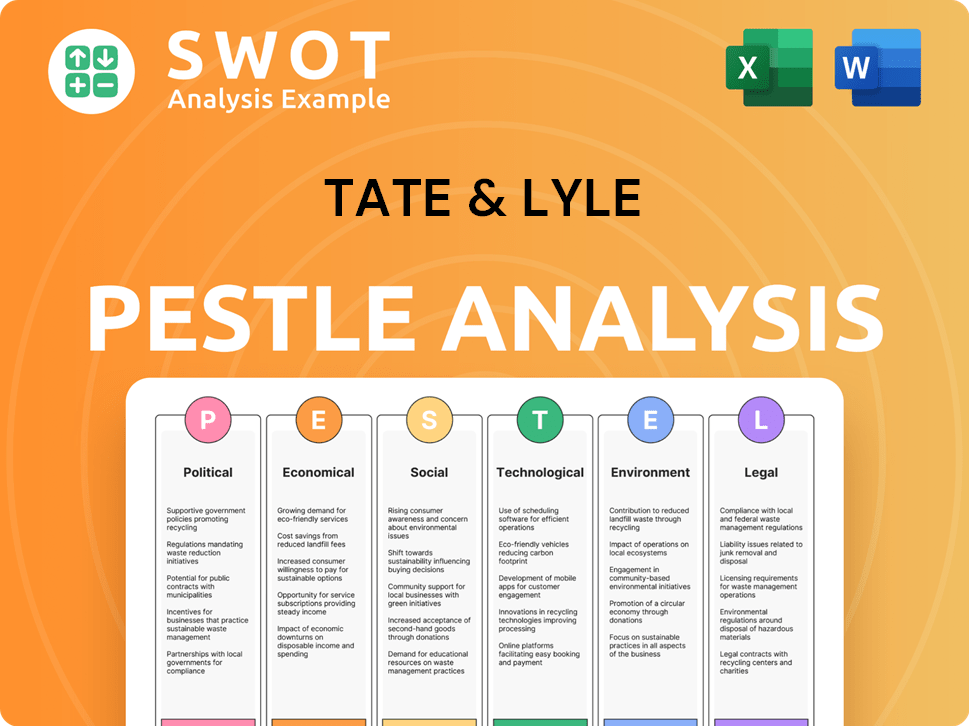
What Is Tate & Lyle’s Growth Forecast?
In fiscal year 2025, ended March 31, the financial performance of Tate & Lyle showed a mixed picture. Revenue increased by 5.4% to £1.74 billion, up from £1.65 billion the previous year. However, pretax profit decreased by 56% to £88 million, significantly impacted by exceptional charges and M&A costs. This performance reflects the dynamics within the global food industry and the company's strategic moves.
The company's strategic acquisitions, particularly the CP Kelco acquisition, have significantly influenced its financial outlook. On a pro forma basis, including CP Kelco from April 1, 2024, revenue for fiscal 2025 reached £2.12 billion. CP Kelco contributed £224 million in annual revenue since its acquisition in November 2024. These figures highlight the company's expansion plans and its efforts to strengthen its position in the food ingredients market. For further insights into the company's target market, you can explore the Target Market of Tate & Lyle.
Looking ahead, Tate & Lyle anticipates revenue growth towards the higher end of its medium-term target range of 4% to 6% annually. However, for fiscal year 2026, revenue growth is expected to be slightly below the bottom end of this range due to tariff uncertainties. Despite these challenges, the company projects EBITDA growth of between 4% and 7% for the year ending March 31, 2025, excluding CP Kelco and in constant currency, with an expected 4% higher EBITDA. With the integration of CP Kelco, the enlarged Tate & Lyle is expected to deliver EBITDA margin improvement and strong cash generation.
Revenue for fiscal 2025 was £1.74 billion, a 5.4% increase. Pretax profit decreased to £88 million due to exceptional charges and M&A costs. This financial performance analysis shows the impact of strategic decisions on the company's bottom line.
The CP Kelco acquisition significantly boosted revenue. Pro forma revenue for fiscal 2025, including CP Kelco, was £2.12 billion. CP Kelco contributed £224 million in annual revenue since its acquisition in November 2024, which is a key part of Tate & Lyle's strategic acquisitions.
Tate & Lyle expects revenue growth towards the higher end of its medium-term target range. EBITDA growth is projected between 4% and 7% for the year ending March 31, 2025, excluding CP Kelco. This demonstrates the company's focus on sustainable food solutions and its growth potential.
Net debt at March 31, 2025, was £961 million, with a leverage ratio of 2.2 times net debt to EBITDA. S&P Global Ratings estimated adjusted debt to EBITDA at close to 3.5x in fiscal 2025, with a forecast to be below 3.0x two years after the transaction close. This is crucial for understanding the company's financial health.
A final dividend of 13.4 pence was declared, a 3.9% increase, bringing the total dividend to 19.8 pence, up 3.7%. Free operating cash flow for fiscal 2025 is estimated at around £60 million-£65 million. This reflects the company's commitment to shareholder returns.
The company is navigating the global food industry with a focus on growth. This includes strategic acquisitions and a commitment to innovation in sweeteners and plant-based ingredients. Tate & Lyle's market share and its impact on the food industry are key factors.
Tate & Lyle Business Model Canvas
- Complete 9-Block Business Model Canvas
- Effortlessly Communicate Your Business Strategy
- Investor-Ready BMC Format
- 100% Editable and Customizable
- Clear and Structured Layout
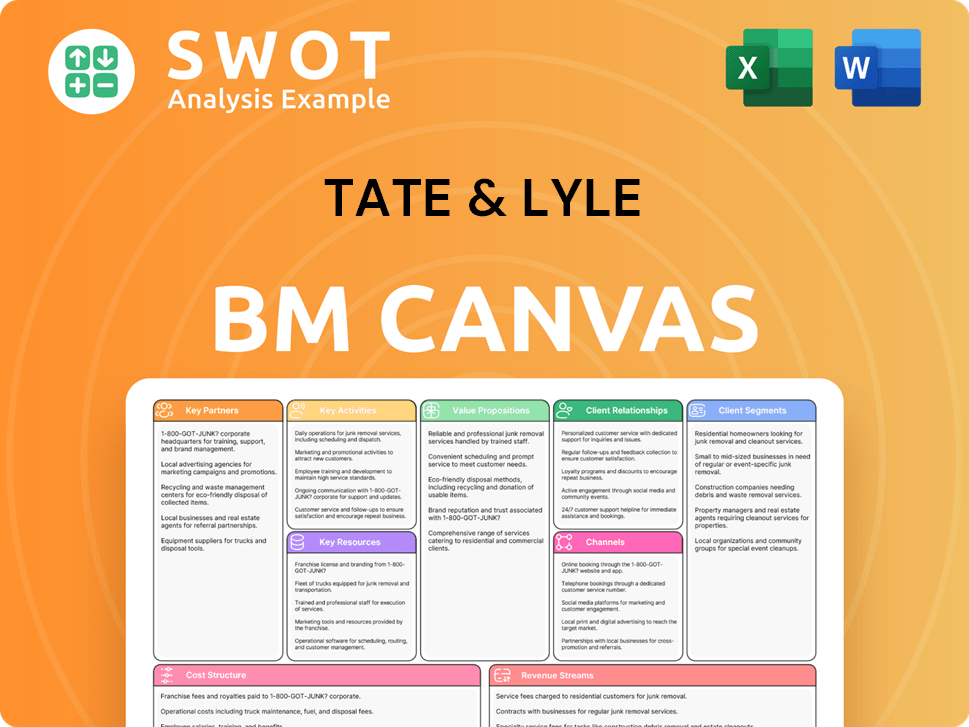
What Risks Could Slow Tate & Lyle’s Growth?
The path to growth for the Tate & Lyle Company isn't without its hurdles. The Tate & Lyle Growth Strategy faces challenges from intense competition in the food ingredients market, especially from major players like Cargill and DuPont. Additionally, the Tate & Lyle Company must navigate the complexities of commodity price volatility and the impact of regulatory changes.
Geopolitical issues, including tariffs, present significant obstacles, increasing costs for both the company and its customers. These pressures have contributed to pricing challenges, despite stable overall market demand. The expected acceleration in demand during the second half of fiscal year 2025 has not fully materialized, adding further strain.
Supply chain vulnerabilities and climate-related events also pose risks. The company is actively addressing these challenges through its enterprise risk management system, with a dedicated focus on climate change and sustainability. Adapting to lower-carbon alternatives may lead to increased costs due to R&D and processing requirements.
The Tate & Lyle Company faces stiff competition within the global food industry. Key rivals like Cargill and DuPont constantly innovate and compete for market share. Understanding the Competitors Landscape of Tate & Lyle is crucial for strategic planning and maintaining a competitive edge.
Fluctuations in raw material prices, particularly for commodities, can significantly affect profitability. While vertical integration helps mitigate some risks, monitoring and hedging strategies are essential. The company's ability to manage these costs will be critical for its Tate & Lyle Future Prospects.
Changes in regulations and geopolitical uncertainties, especially trade tariffs, can disrupt supply chains and increase operational costs. These factors can affect the Tate & Lyle Growth Strategy, especially impacting international trade and market access. The company must adapt to these external pressures.
Disruptions in the supply chain and the impact of climate-related events, such as extreme weather, present significant risks. These events can affect production, damage assets, and increase operational costs. The Tate & Lyle Company is investing in resilience and sustainable practices.
Despite stable market demand, pricing pressures can affect revenue and profitability. The failure of anticipated demand acceleration can exacerbate these challenges. Effective pricing strategies and cost management are crucial for maintaining financial performance.
The shift towards sustainable food solutions requires investment in research and development. Adapting products to lower-carbon alternatives may increase costs. Tate & Lyle's commitment to sustainability is key for long-term success in the global food industry.
To mitigate commodity price risks, Tate & Lyle leverages vertical integration and hedging strategies. These measures help stabilize input costs and protect profit margins. Effective risk management is vital for the Tate & Lyle Company.
The company is actively adapting to climate change by incorporating climate-related risks into its enterprise risk management. This includes assessing the impact of extreme weather events and investing in more resilient infrastructure. This is critical for the Tate & Lyle Future Prospects.
Tate & Lyle Porter's Five Forces Analysis
- Covers All 5 Competitive Forces in Detail
- Structured for Consultants, Students, and Founders
- 100% Editable in Microsoft Word & Excel
- Instant Digital Download – Use Immediately
- Compatible with Mac & PC – Fully Unlocked
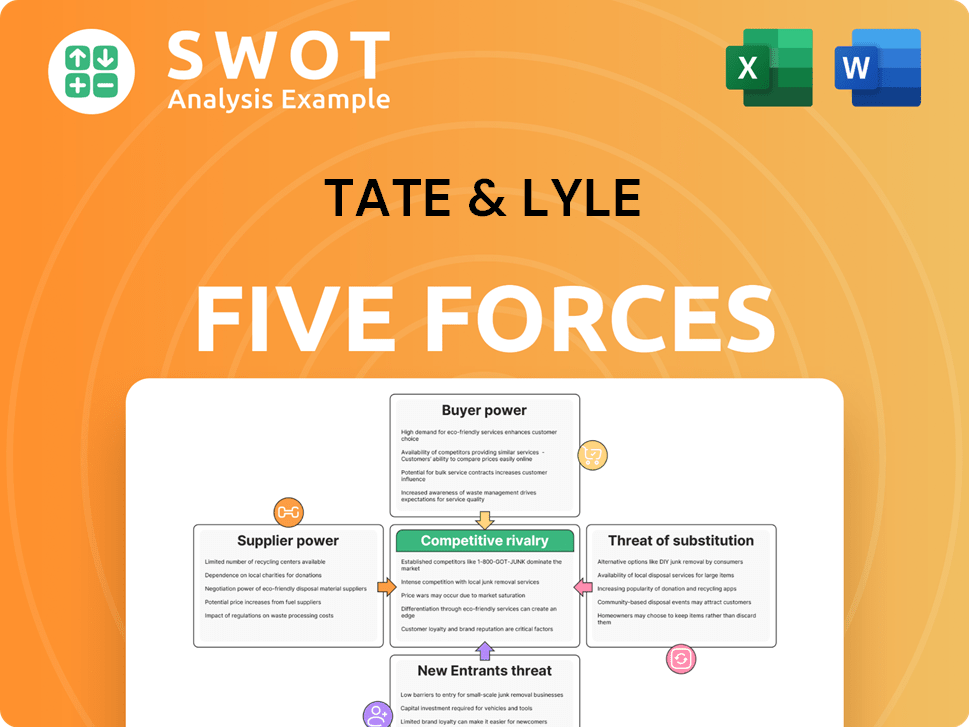
Related Blogs
- What are Mission Vision & Core Values of Tate & Lyle Company?
- What is Competitive Landscape of Tate & Lyle Company?
- How Does Tate & Lyle Company Work?
- What is Sales and Marketing Strategy of Tate & Lyle Company?
- What is Brief History of Tate & Lyle Company?
- Who Owns Tate & Lyle Company?
- What is Customer Demographics and Target Market of Tate & Lyle Company?
Disclaimer
All information, articles, and product details provided on this website are for general informational and educational purposes only. We do not claim any ownership over, nor do we intend to infringe upon, any trademarks, copyrights, logos, brand names, or other intellectual property mentioned or depicted on this site. Such intellectual property remains the property of its respective owners, and any references here are made solely for identification or informational purposes, without implying any affiliation, endorsement, or partnership.
We make no representations or warranties, express or implied, regarding the accuracy, completeness, or suitability of any content or products presented. Nothing on this website should be construed as legal, tax, investment, financial, medical, or other professional advice. In addition, no part of this site—including articles or product references—constitutes a solicitation, recommendation, endorsement, advertisement, or offer to buy or sell any securities, franchises, or other financial instruments, particularly in jurisdictions where such activity would be unlawful.
All content is of a general nature and may not address the specific circumstances of any individual or entity. It is not a substitute for professional advice or services. Any actions you take based on the information provided here are strictly at your own risk. You accept full responsibility for any decisions or outcomes arising from your use of this website and agree to release us from any liability in connection with your use of, or reliance upon, the content or products found herein.